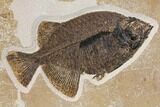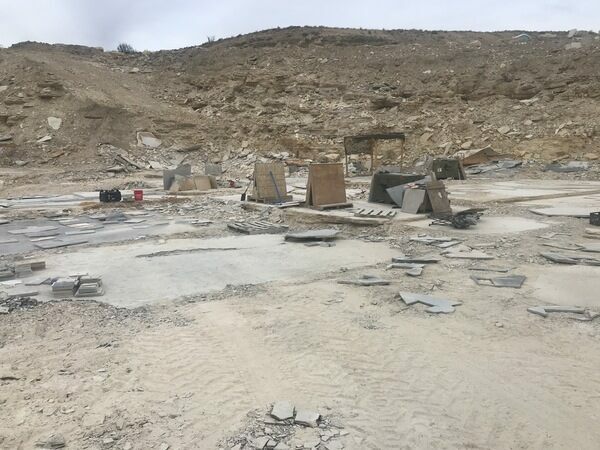This Specimen has been sold.
29.8" Fossil Fish (Phareodus & Mioplosus) Plate - Wyoming
This is a darkly preserved, 12" long Phareodus testis and 9" long Mioplosus labracoides association, both of which are the more uncommon species of fish from this formation. This large specimen was collected from the famous 18 inch layer of the Green River Formation in Wyoming. The slab of rock they're on measures 29.8" wide by 14.7 tall.
This large fish plate has been backed with a wood board and has two ring hangers for a hanging presentation.
This large fish plate has been backed with a wood board and has two ring hangers for a hanging presentation.
About Phareodus
Phareodus is a genus of predatory freshwater fish found in the famous Fossil Lake deposits of the Green River Formation in Wyoming. It had a mouthful of sharp pointy teeth, making it a voracious lake predator. In fact, the name Phareodus actually means "to have teeth". Spines from other fish such as Mioplosus and Priscacara have frequently been found preserved in their stomachs.
Phareodus is a genus of predatory freshwater fish found in the famous Fossil Lake deposits of the Green River Formation in Wyoming. It had a mouthful of sharp pointy teeth, making it a voracious lake predator. In fact, the name Phareodus actually means "to have teeth". Spines from other fish such as Mioplosus and Priscacara have frequently been found preserved in their stomachs.
Mioplosus is a genus of large extinct perciform fish that lived through the Eocene epoch. This genus is easily distinguished by an elongate fusiform body, double dorsal fins, and forked tail. Mioplosus was a solitary predator with large teeth: a few fossil specimens have been collected with other, smaller fish lodged in their throats. Most fossils of this genus are from the Tertiary-aged Green River Formation in Wyoming, though relatives of this genus are known to range throughout Asia and New Zealand. Mioplosus is also believed to be related to the modern pike-perch of the genus Sander (Stizostedion).
About The 18 Inch Layer Of Fossil Lake
Specimens like this come from the coveted 18 inch layer of the Green River Formation, which produces darker and more detailed fish than the majority on the market. The rock from this layer is much harder and more durable than other layers in the formation, likely due to its initial deposition conditions in deep water. Because of these conditions, fish found in the 18-inch layer can be extracted whole and in excellent condition. This layer is typically collected at night using low-angle light to see the bump in the rock that the fish's backbone creates. They then cut these fish out and take them to a lab where the fish, which may be up to an inch under the surface of the rock, are meticulously extracted under microscope with hand tools.
Specimens like this come from the coveted 18 inch layer of the Green River Formation, which produces darker and more detailed fish than the majority on the market. The rock from this layer is much harder and more durable than other layers in the formation, likely due to its initial deposition conditions in deep water. Because of these conditions, fish found in the 18-inch layer can be extracted whole and in excellent condition. This layer is typically collected at night using low-angle light to see the bump in the rock that the fish's backbone creates. They then cut these fish out and take them to a lab where the fish, which may be up to an inch under the surface of the rock, are meticulously extracted under microscope with hand tools.
SPECIES
Phareodus testis & Mioplosus labracoides
LOCATION
Kemmerer, Wyoming
FORMATION
Green River Formation, 18 Inch Layer
SIZE
29.8 x 14.7" shale
CATEGORY
SUB CATEGORY
ITEM
#144006
We guarantee the authenticity of all of our specimens.
 Reviews
Reviews













